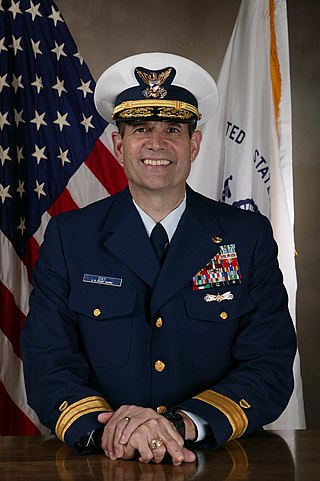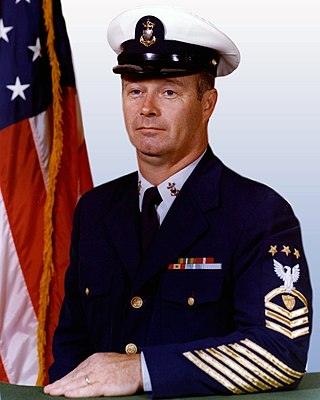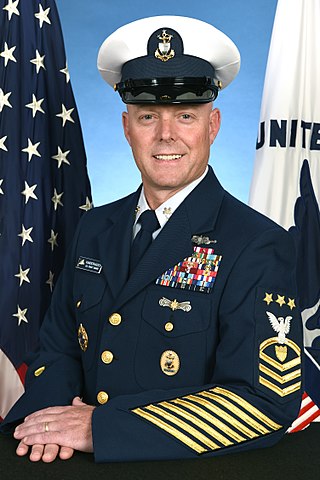The Enlisted Person of the Year Ribbon is a decoration of the United States Coast Guard which was established in 1999, though retroactive to 1994, by order of the Commandant of the Coast Guard.

John William Kime was an admiral of the United States Coast Guard who served as the 19th commandant from 1990 to 1994.

Edwin John Roland, was a United States Coast Guard admiral and served as the twelfth Commandant of the Coast Guard from 1962 to 1966. During his tenure, Roland oversaw the replacement of many World War II era cutters under fleet modernization programs. He also assisted the U.S. Navy with operations in Vietnam by supplying crews and cutters for Operation Market Time. Roland was noted for his support in efforts to bring international safety standards to merchant shipping. Although Roland was already retired when the Coast Guard was transferred from the Department of Treasury to the newly formed Department of Transportation in 1967, he was largely responsible for the planning for the move and the Coast Guard retaining its military responsibilities along with its transportation related functions.

Franklin A. Welch was the ninth Master Chief Petty Officer of the United States Coast Guard. Welch entered the Coast Guard in 1980 after graduating from Shades Valley High School Class of 1978, in Birmingham, Alabama. A former Master Chief Quartermaster, he served in office from October 10, 2002, to June 14, 2006, and served in the Coast Guard for over 26 years.

Charles Luther Calhoun was an American military enlisted man who served briefly in the United States Navy during World War II and then in the United States Coast Guard where he would rise to become the first Master Chief Petty Officer of the Coast Guard.

John C. Acton is a retired United States Coast Guard rear admiral who served as the Director of Operations Coordination for DHS. Acton formerly served as Director of the DHS Presidential Transition Team.

Master Chief Aviation Electronics Technician Eric Anthony "Rick" Trent served as the seventh Master Chief Petty Officer of the Coast Guard from July 1, 1994, to May 31, 1998.

Ronald James Rábago is a retired United States Coast Guard rear admiral who in 2006 became the first person of Hispanic American descent to be promoted to flag rank in the United States Coast Guard. He retired as the assistant commandant for engineering and logistics and the United States Coast Guard's chief engineer in 2014.

Steven E. Day is a United States Coast Guard rear admiral whose final duty assignment was Director of Reserve and leadership, (CG-13). In this role he commanded the United States Coast Guard Reserve. He previously served as the US deputy commander for mobilization and reserve affairs, Atlantic Area, US Coast Guard.

Michael Phillip Leavitt was the eleventh Master Chief Petty Officer of the Coast Guard (MCPOCG). He assumed the position from MCPOCG Charles W. Bowen on May 21, 2010 and was relieved on May 22, 2014, by Steven W. Cantrell. Leavitt was previously serving as the Senior Enlisted Advisor to the Deputy Commandant for Operations at Coast Guard Headquarters, Washington, DC.
Captain Charley L. Diaz is a 30-year United States Coast Guard veteran who served on Active Duty from 1982 to 2012. Diaz is best known for leading the crew of the USCGC Sherman (WHEC-720) in the seizure of the Panamanian freighter GATUN off the coast of Panama in March 2007, which netted nearly 20 tons of cocaine worth an estimated $600 million. It was the largest maritime drug bust in US history.

Allen William Thiele was the fifth Master Chief Petty Officer of the Coast Guard, serving from 1986 to 1990.
Theodore Joseph Wojnar is a former rear admiral in the United States Coast Guard.

Philip Francis Smith was the second Master Chief Petty Officer of the Coast Guard, serving as the enlisted advisor to the Commandant of the Coast Guard, from 1973 to 1977.

Hollis Byron Stephens was the third Master Chief Petty Officer of the Coast Guard, serving as the enlisted advisor to the Commandant of the Coast Guard from 1977 to 1981.

Robert Jay Lloyd was the sixth Master Chief Petty Officer of the Coast Guard, serving as the enlisted advisor to the Commandant of the Coast Guard, from 1990 to 1994.

USCGC Bailey Barco (WPC-1122) is the United States Coast Guard's 22nd Sentinel-class cutter, and the second to be stationed in Alaska, where she was homeported at Coast Guard Base Ketchikan.

Jason M. Vanderhaden is a retired petty officer of the United States Coast Guard who served as the 13th Master Chief Petty Officer of the Coast Guard from May 17, 2018 to May 19, 2022. As MCPOCG, Vanderhaden served as the principal advisor to the Commandant of the Coast Guard on all enlisted personnel matters. As a matter of protocol, this gave him precedence equal to that of a three-star officer.

Oliver Henry was a Coast Guardsman who served from 1940 to 1966 in the United States Coast Guard. When Henry started serving in the Coast Guard, the United States Armed Forces were still racially segregated so he served as a mess steward, an all black rating. He was the first black to transfer from the mess steward rating. He was transferred to the motor machinist mate rating – related to his pre-service work as an auto mechanic.

Nathan A. Moore is a US Coast Guard Rear Admiral and commander of the Seventeenth Coast Guard District.

















